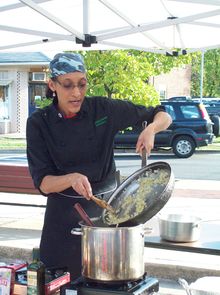Riverdale Park, Maryland
The area was first developed in 1801 when a Belgian aristocrat, Henri Joseph Stier, purchased 800 acres situated between two tributaries of the Anacostia River, known as the Paint and Northwest branches.The mansion was modeled after the Stier family's Belgian home, Chateau du Mick, and when completed in 1807, the building stood as a two-story stuccoed-brick dwelling in the style of late Georgian architecture.Just two years after purchasing the property, in 1803, the political tension that had caused Stier to flee his native country subsided, and he and his wife, Marie Louise, returned to Belgium.During his life, Charles Calvert conducted a variety of agricultural experiments at Riversdale, and expanded his family's original holdings to 2,200 acres.The 1861 Martenet map depicts the rural setting of Riversdale and identifies Charles B. Calvert as its owner.In 1887, the heirs of Charles Benedict Calvert sold 474 acres of land to New York City businessmen John Fox and Alexander Lutz in two separate transactions.On March 23, 1889, Fox and Lutz formed the Riverdale Park Company, which was named in honor of the grand Federal style mansion at the center of the proposed community.The new roads were named in honor of United States presidents and were arranged in a grid pattern that surrounded a central ellipse, which served as the site of the commuter train station.Laid out as a "villa park", the community featured traffic circles and green space, with the mansion being used as its central amenity.The three original sections of the suburb used relatively uniform lot dimensions and building setbacks, thereby creating a cohesive development of middle- and upper-middle-class housing.By the turn of the twentieth century, Riverdale Park comprised 60 dwellings, a Presbyterian church, a schoolhouse, and a railroad station.Blundon also, independent of the development company, purchased several lots each year for the purpose of overseeing the construction of single-family dwellings.In 1941, the town changed the name of its roads to conform to the standards of the United States Postal Service, carrying a similar pattern as those of Washington, D.C., and nearby College Park.The increasing population and commercial and governmental growth of metropolitan Washington, D.C., most notably during the last twenty years of the twentieth century, has resulted in further development of the town of Riverdale.Since the 1940s, the area has been a largely blue-collar town predominated by small red brick or wooden homes with porches.Washington, D.C., and its close northern and northwestern suburbs once had large blue-collar Irish populations some of this influence is still evident in the remnants of the older community.In 1998, the town was officially renamed Riverdale Park.In April 2017, it opened as Riverdale Park Station, a mixed-use development located at the odd side of the 6600 to 6700 blocks on Baltimore Avenue.Prince George's County Police Department District 1 Station in Hyattsville serves Riverdale Park.The Liberian born pro footballer immigrated to Riverdale Park and has represented the United States at the U-16 International level.









CountyPrince George'sIncorporatedTime zoneEastern (EST)Area code(s)301, 240FIPS codesemi-urbanPrince George's CountyWashington, D.C., metropolitan areaSt. Mary's City, MarylandUniversity of Maryland, College Parkstreetcar suburbsU.S. Route 1College ParkUniversity ParkEdmonstonHyattsvillearistocratAnacostia RiverNorthwestFrench RevolutionRiversdalestuccoed-brickGeorgian architectureRosalieGeorge CalvertCharles Calvert, 5th Baron BaltimoreCharles Benedict CalvertUniversity of Maryland at College ParkUnited States Department of AgricultureUS Route 1Baltimore & Ohio RailroadFederal styleBaltimoresetbacksupper-middle-classFoursquaresPresbyterianGeorgetownMaryland General AssemblyCarla HallUnited States Postal Serviceblue-collarUniversity of MarylandM-NCPPCWhole Foods Market2010 CensusAfrican AmericanNative AmericanPacific Islanderother racesHispanicLatinoPrince George's County Police DepartmentPrince George's County Public SchoolsParkdale High SchoolBladensburg High SchoolNorthwestern High SchoolCollege Park Academy Public Charter SchoolAnimal and Plant Health Inspection ServiceMaryland Route 201Maryland Route 410Interstate 95Interstate 495MD 431MetroBusTheBusRiverdaleCamden LinePurple LineWashington MetroAmtrakMoses NyemanD.C. UnitedMajor League SoccerUnited States Census BureauRiversdale (Riverdale Park, Maryland)U.S. Postal ServiceMaryland-National Capital Park and Planning CommissionPrince George's County, MarylandCounty seatUpper MarlboroCitiesDistrict HeightsGlenardenGreenbeltLaurelMount RainierNew CarrolltonSeat PleasantBerwyn HeightsBladensburgBrentwoodCapitol HeightsCheverlyColmar ManorCottage CityEagle HarborFairmount HeightsForest HeightsLandover HillsMorningsideNorth BrentwoodAccokeekAdelphiAndrews AFBAquascoBeltsvilleBrandywineBrock HallBrown StationCalvertonCamp SpringsCedar HeightsCedarvilleChillumClintonCoral HillsEast RiverdaleFairwoodForestvilleFort WashingtonFriendlyGlassmanor